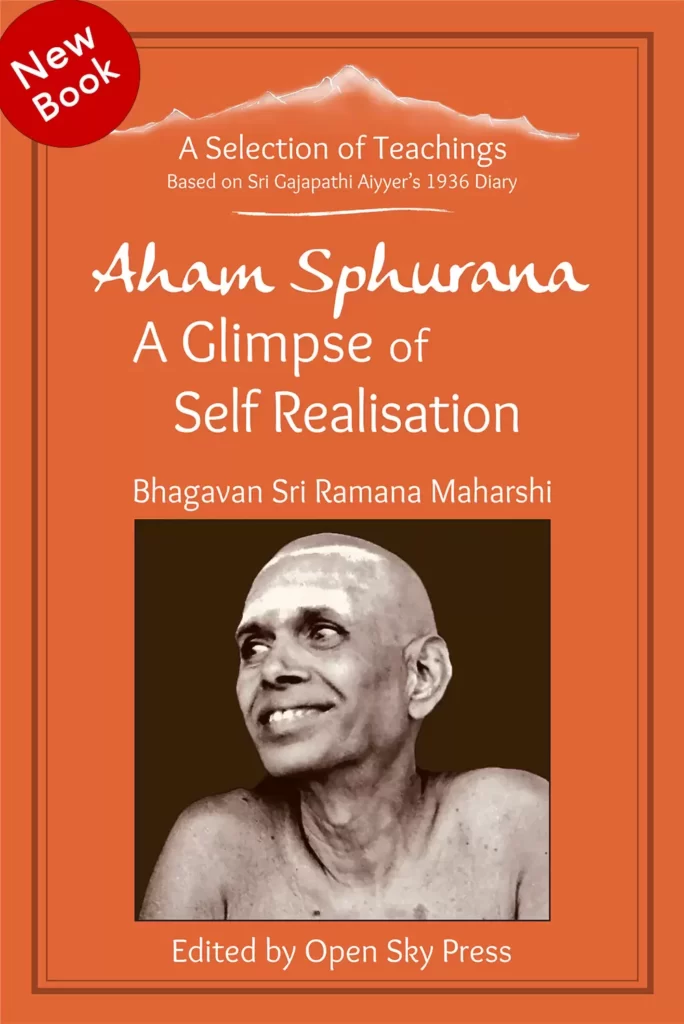
Aham Sphurana
A Glimpse of Self Realisation
New Book about Sri Ramana Maharshi

Available Worldwide
On www.openskypress.com and Amazon:

“In my opinion, Aham Sphurana, a Glimpse of Self Realisation, will become a Treasure Trove of Wisdom to the Seekers of Truth in general, and particularly to the devotees of Bhagavan.”
Swami Hamsananda – Athithi Ashram, Tiruvannamalai
The Aghori’s Death and Liberation
After coming back from the 11AM luncheon, Bhagavan called me aside unobtrusively and told me in a low voice: “Go to your room now. Sleep soundly for some time. Arrive here again at 9 PM. Carry something to eat with you. Is it understood?” Unquestioningly, I nod my head and depart at once.
27th August, 1936
The clock in the Hall quietly chimes 1.15 AM. Everyone is asleep. The master, seated majestically on the Sofa as usual, smiles at me and gestures me to rise. Noiselessly the master and I leave the Hall. I go toward the office, but the master catches hold deftly of my wrist, and twitches his head towards Palakoththu. I am thrilled by his touch, and it brings forth goosebumps of ecstatic joy all over my skin. Silently we move under the cover of the naked, pitch-black sky. I cannot see my way, and merely follow the master blindly, as I do in all of life itself. The heavy clouds overhead block whatever sparse light the heavens want to allow.
Eventually we find ourselves at the derelict shrine of Draupadiyammman, situated some distance away from Palakoththu, and enter. Sri Maharshi signals me to stop. There is a sound coming from within the mandapam: someone is breathing heavily, in strained fashion. Bhagavan whispers to me, ‘Gaja! Quick- whistle the Ramana-sadhguru-rayanae tune!’. I am puzzled but I do as I am told. There is a sudden sound of a match-stick being struck, and I am startled. A moment later, the dilapidated shrine is lit by the light of a kerosene-lamp. Three anthropomorphic figures apart from Bhagavan. and myself are illumined by it- the rudraksha-adorned attendant, the astrologer- hermit, and crouching by the feet of the astrologer-hermit, the Aghori.
The Aghori’s body is contorted by violent spasms that heave him up and down. He seems to be suffering from some sort of serious breathing difficulty. The attendant says, ‘Nambiarayya will be here in 10 minutes. The Maharshi terminates his bandage with a single unambiguous gesture of the hand, conveying his instruction that silence must be maintained. The only sounds heard are the chirping of crickets, the hooting of an owl or two, the occasional creaking of some branch and a cow moaning intermittently at some indeterminately far-flung distance. The hermit carries the lamp; the attendant carries a few jute bags which seem heavily laden; the Aghori seems incapable of carrying himself even. Presently a large jutka [horse and carriage] arrives, sonorously tearing into the largely silent atmosphere of that momentous, unforgettable night.
A man with an almost Caucasian face steps out. In the inexplicably poignant, yellowish glow of the kerosene lamp, his refined, splendidly Aryan features stand out starkly against those of the others. I recollect he is a Malayali whom I have seen in the ashram once or twice. The driver, proclaiming that he is going to come down to help us, is about to alight from his seat; but Bhagavan merely with the usual adroit, magisterial combination of a debonair maneuver of his empyrean head and an elegant gesticulation with his facial accentuations, instantly draws the Malayali’s attention to the fact. The Malayali rushes toward the man and convinces the flummoxed creature to stay put. Now Bhagavan. hurries toward the vehicle, and all follow.
Without further ado the Malayali unflinchingly heaves the huge sacks into the carriage and helps Bhagavan up. The attendant and the hermit, prior to themselvesmounting, manage to help the Aghori up, and Bhagavan himself pulls him inward. I am the last to get in. The Malayali softly instructs the driver to start, and the horse begins trotting. It is a terrific squeeze inside the carriage, and the Malayali tries to murmur an apology for it, but is stopped by the gurgling noises made by the Aghori’s throat from time to time. The Aghori, for want of space, is seated on the master’s own lap. I offer to take him on mine, but the master makes no response.
The Aghori seems to be largely oblivious to his surroundings. The Maharshi asks the hermit to dim the lamp to a tiny flame, and is instantly obeyed. The horse trots on and on. We reach the region wherein there is a fork in Chengam-road. The carriage takes right, the Girivalam path. On the right Arunachala towers over us puny mortals like the Living God He verily IS. We penetrate the heart of the forest, going inward and inward.
The dirt-track is narrow. Sometimes one of the wooden wheels heaves violently when a large pebble is run over. I am surprised that a jutka driver has agreed to come this far. One cannot help being drowned in the portentous feeling that something spectacularly momentous, something utterly magical, is going to happen. True to the master’s teachings, the whole scene seemed a scintillating dream… I close my eyes and drown myself in the steady rhythmical whirr of the jutka’s wooden wheels, evidently once upon a time gaily painted red and yellow. I become unconscious to the passage oftime, and the master’s ethereal presence beside me on this unexpected, mysterious voyage seems to elevate me to heights of dizzying Love hitherto unexplored by the reticent soul.
The Malayali’s voice cracks out like a whip into the stillness of the night. The horse halts, and we all alight in the middle of the forest. To my astonishment, the Malayali says something to the driver, hands him some coins, and the jutka speeds headlong into the “rough path ahead and then briskly away into the jasmine-scented tropical night”; we are abandoned here! The asthenic Aghori is struggling to draw breath. He has collapsed onto the dirt-track, holding Bhagavan’s knees in perfervid supplication and pressing his face between them. He is carried to the right-hand-side edge of the dirt-track and bade sit down there. He collapses in a few moments, writhing like a mating snake. Everyone rushes forward to raise him to a seated posture again, but the master indicates unto them to stay put. He sits down in padmasana [ Lotus position] in front of the flailing Aghori on the ground. He impresses the old man’s brow gently with his palm. The Aghori becomes at once relaxed. Of his own accord he sits up facing the master. His respiratory trouble has abated somewhat.
He presses his palms together in front of his chest and starts weeping like a child. The Maharshi smiles at him sweetly as an infant would at a toy. ‘Swami, pogalam!’ [Swami, we may go!] says the Aghori, still convulsed with tears of ecstacy. The Maharshi then acts rapidly: he pushes down the Aghori’s joined palms, presses his left hand against the Aghori’s eyes, and lodges his right against the right-hand side of the Aghori’s chest. The Maharshi’s face seems prima facie impassive; yet its apodeictic stillness betrays the depth of his concentration. Presently the Aghori starts shrieking; the Maharshi’s imperturbable eyes flicker for an instant- Inclining his chin upward to indicate what he wants, he says urgently, ‘Gaja! Pick up this piece of red-rock yonder.’
I hand it to him, but he says: ‘Firmly press it down upon his head! Quick! Hold his chin fast with the other hand.’ The Aghori has become mute; yet his body keeps quivering. The Maharshi says soothingly, ‘Kavalaippadadhingoe thatha; amma kitta dhan thirumbapoeroem.’ [“Avoid your Doubts! Oh! Great man! Where we return is our natural place which is our motherland called as Athma”]
Then the old man ceases to offer any resistance, and I begin to ease my grip on his head and chin. ‘No!’ ejaculates the Maharshi; ‘Hold fast until ordered to relent!’ For the next quarter-of-an-hour, there is no change in the scene- the Maharshi’s position, the Aghori’s and mine all remain frozen; yet, as though a magnetic field has suddenly emanated out of him in a violent eruption, from Bhagavan’s person an intense radiation of peace continually fulminates out, palpably soaking me in its ecstatic current. Then, a beautiful, serene smile appears on the Aghori’s harrowed face. A single, small, solitary tear slowly dislodges itself from his right eye, flows over his nose, and poising itself at the tip thereof, sparkles, glittering in the light of the kerosene lamp like some celestial diamond glowing from Indra’s crown.
Bhagavan’s face assumes a beatific charm. The word ‘amma’ [mother] escapes the Aghori’s lips, and the mouth falls open; the lone tear-drop falls onto a rock below and shatters into shivers infinitesimal and innumerable; and the head becomes limp andlolls in my hand, never to have to assert itself again. ‘Alright,’ says Bhagavan with an enchanting smile, an enthrallingly electrifying radiance lighting up his sublimely rhapsodical face; I withdraw my hand. Bhagavan calls out to the others. The attendant and the Malayali extract a small சமக்காளம் [mat] from one of the sacks and spread it near what was once considered the Aghori.
Bhagavan removes his hands and the cadaver falls like a logged tree, squarely upon the blanket. They carry it reverentially a few yards away from its incumbent spot, and place it by the side of what seems to be a heap of crumbled wooden-shavings, lying some distance into the edge of the dirt-track. Soon the attendant and the Malayali set to work with spades. All the shavings are soon extricated and cleared away in a matter of moments. Within no time we behold a cylindrical pit of about 3 feet in diameter and 5 feet in height gaping up at us. The pit has been furrowed out in the midst of a small clearing in the dense vegetation. As one were to come in circumambulation around the Hill, it would fall to one’s right; but it would not be visible from the dirt-track. One had to traverse a small patch of thickets before one came to it.
At the bottom, the pit seems to contain something greyish, a powdery substance. Just when I am wondering what it might be, the Malayali’s voice announces softly unto Bhagawan, ‘As per Bhagavan’s instructions we have already sprinkled salt, thiruneer and powdered camphor at the bottom. The shalagramam [a special black stone] contributed by Shastriar has also been embedded at the bottom of the pit. Thinking that Bhagavan as well would like to offer some oblation [ an offering], we have brought some thiruneer along with us now also…’. He hands out a yellow cloth-bag, and while Bhagavan is sprinkling its contents into the pit, the hermit beckons me and hands me a brass pot, himself carrying two. He asks me to accompany him somewhere.
We cross to the other side of the dirt-track and walk for a few minutes, keeping the Hill to our right. I ask him, ‘Why has Bhagavan chosen this particular unidentifiable spot at Tiruvannamalai to inter the body of this sadhu, Purampoekku chamiyar? It seems he has carried out the operation in a clandestine manner…’. The other responds, ‘The ways of a Jivanmukta are impossible for us to understand; they are beyond thecomprehension of ordinary mortals. Many weeks ago, even before this sadhu has first come to the ashram, Bhagavan. asked me to procure the shalagramam and keep it with myself until apposite circumstances should materialise. Jnanis are omniscient…’ Soon we arrive at a small, weed-covered water-body- a tiny pond. ‘This is the varuna-theertham. See its pathetic neglected condition.’ says the hermit plaintively. We collect water to the brim in our three brass pots and return.
The Aghori’s cadaver, wrapped in the சமக்காளம், [Mat] has already been lowered into the pit, in a highly curious posture- somewhat akin to how a foetus would, one might suppose, sit inside the womb. The forearms are clasped against the chest. The folded knees are pressed against the folded upper extremities. The spine is slightly bent over. The chin is tucked into the chest. The scene appears slightly eerie because it looks as though the man is purposely resting his cheeks upon his wrists. All of us then go to a nearby mound of freshly-dug earth [evidently extracted some time ago so as to form this pit] and fill the pit, chanting, Annamalaikku Aroegara! Bhagavan wants to participate in the work, but there are only three spades available. So the attendant, myself, and the Malayali manage to finish off the work.
Bhagavan throws in handfuls of earth towards the end. The earth visible above the ground is then formed into a well-packed low mound. Thus far we have found the work easy, but now we struggle with a large, heavy sculpted-stone. It is a circular stonemimicking the pedestals anthropomorphic moolavamoortis [are generally made to] stand upon in temples. On top is sculpted in high-relief a pair of
dainty feet. This is placed on the mound, and sunk some way inward. Bhagawan one by one collects the brass pots from us. Thrice he silently pours water on the stone. As he is doing this, I twaddlingly chant, almost ad libitum: ‘Om pranaya svaha, apanaya svaha, vyanaya svaha, udanaya svaha, samanaya svaha, brahmane svaha!’. The hermit looks scandalised, but Bhagavan only laughs and says, ‘Yes; he has already done all that…‘.
The Malayali beseechingly asks that this remark of Bhagavan‘s be explained to him. The master says,
” Renouncing body-consciousness and the faculty facilitating personal identification with the four-pronged corporeal activity of excretion, digestion, circulation and respiration, I offer myself as oblation unto the Supreme Brahman. ” is the import of the chant. But nowadays people think it is an appetising agent. [laughs] They say it aids proper digestion. The actual purpose of the shloka is that whilst eating, the thought, ‘I am indulging in eating.’ should not occur. The body’s activities should not lead to the viscosification [ ] of any vritti [tendancies] of the mind; otherwise there will be no end to bondage.
Everyone in our entourage prostrates first to the Hill, then to Bhagavan and then to the samadhi of the Purampoekku chamiyar. Looking at nobody in particular, Bhagavan says soberly, ‘Don’t go and blabber anywhere [i.e., to anyone] about all this.’ All promise that they shall do no such thing. Then we start from the place. Recollecting the aptness of my name in such context, I mentally invoke the blessings of the ‘elephant-trunk’ face of Lord Arunachala whilst traversing this segment of the girivalam path. The attendant anxiously asks: ‘I forgot to remove my rudraksha whilst interring the body; has it amounted to an offence?’.
B.: says, ‘No, there was no pollution.’.
The Malayali: Bhagavan means, the sadhu was freed from future birth due to Bhagavan’s Grace?
B.: This sadhu was no ordinary man. He is an example of the Redeeming- power of unconditional Love for God- Love which knows no sanity. Be it unconditional Love or unconditional surrender, the one implies the other and the other the one. He has not come here so easily- he came ripe for Emancipation. It is a pity that some must struggle so excessively to Realise what IS always here and now.
M.: What was the significance of the location chosen to inter him- if I may know?
B.: An interpretation once given by Nayana says that the 5 peaks of this Hillrepresent the five bhavas which one may bear towards God. The sadhu we interred had all the bhavas except the shanta. However, this is merely a conjencture; it is being given to you only because you solicit an explanation; if presented with a theory which appears to cohere with the ideas already impregnated in your mind, for the time being you feel satisfied. But what is the truth? Events take place only from the point of view of one who conjures them up in his imagination. Really, nothing ever happened and nothing can ever happen. Are you aware of occurrance of any transformation or transmutation in the state of deep slumber? It is upon waking, when the mind becomes active again, that you say ‘I slept.’. The nivritti state, wherein one abides without mental modifications or the comings and goings of a world, is the gateway to the Absolute.
M.: That is the Jnani’s point of view.
B.: That is the truth.
M.: Why has Sri Bhagavan maintained secrecy about the sepulture of this sadhu?
B.: As in life, so in death. He lived in abnegation of himself. He lived only indeath. The Bible says, ‘…death worketh in us, but life in you.’; and again, ‘…that which thou sowest is not quickened, except it die.’. One who would have Life Eternal must perish in It.
M.: Tacitus has made the apt observation, ‘Eo magis praefulgebat quod non videbatur.’; and Pope, ‘How happy is the blameless vestal’s lot! The world forgetting, by the world forgot.’.
B.: Yes, yes. Really birth and death are just ideas. These ideas arise because we take ourselves to be the body, and identify with it saying “I”. If all such mistaken notions are given up, what remains is only the Real. Then there cannot be any question of birth or death- only the One would BE. The following words are attributed to the Egyptian priest Mercurius ter Maximus: Et sicut res omnes fuerunt ab uno, meditatione unius, sic omnes res natae ab hac una re, adaptatione. Salvation is only giving up everything. So, there is no need to “attain” or “accquire” freedom; only yourself remain free [of the ego]- i.e., free yourself [of the ego]. God is not withholding our Salvation- we are. ‘Letting go’ is Salvation. That is the import of the saying, “Liberavi animam meam.”.
Bhagavan walks quickly, so much so that after a time even myself, a youngster, find itstrenuous to maintain my tempo in keeping tandem with him. Looking at the Malayali’s puffed face, the master laughs and slows down slightly. The Malayali asks Bhagavan if he had better hire a jutka, if any were found available at this time, as soon as our party were to arrive in town; otherwise, he fears, Chinnaswami might be awake and observant upon our arrival at the ashram, and ask awkward questions. But apparently, B. does not fancy anymore jutka- transport. Says he with a titter, ‘Don’t worry about Chinnaswami. He will be fast asleep when we reach; rats are giving him plenty of trouble in his dreamsalso; they will not permit him to awaken so soon…’
At length we reach the temple. I am fatigued beyond measure but try to continue along, not wanting to prematurely terminate the pleasure of walking behind the master. The master would not hear of it. ‘If you strain the body beyond the margin of exertion it can safely tolerate, it will crumple.’, says he. So, albeit unwilling, I
am chaperoned all the way up to the start of the small lane wherein is the room I am lodged in. For a time I stand and watch the receeding backs of my Jehovah Sanctus Unus and the three men that accompany him. Then I climb up to my room and, succumbing to the seductive arms of weariness, instantaneously plunge into slumber.
The above conversation between Bhagavan and the Malayali went on in Malayalam, unsurprisingly. Except for the Latin sayings and Bible quotes I could understand nothing. Later I privately approached the gentleman, a Mr. Nambiar, for elucidation of what ஆன்மீகக் கருத்துகள் [spiritual ideas] conveyed unto him on that vividly memorable night. Today Mr.Nambiar has become world-famous among Sri Bhagavan’s devotees around the globe, because he has painstakingly photographed the master with a Cinematographic-camera, a year before the master gave up the body. I think the ashram has been provided with a copy of the reel.
The master preferred that the fact of occurrence of the obsequies he so graciously chose to arrange for the Purampoekku chamiyar be not made public. Accordingly during his lifetime in the flesh nobody was informed of it. Now it would be a shame to not reveal this one more incident demonstrating the nobility of his character and the gargantuan loftiness of his spiritual prowess.
Your guess is correct, dear reader: on this day’s diary entry, I consciously mimicked Mr. Brunton’s verbose and circumlocutory style of writing, as also his deliberate, hyperbolic usage of the simple present tense to bring out a stylish and grandiloquent effect, just to see what it would turn out like! Hope you liked it, heh-heh!
Generally, wherever I have incorporated the master’s original words in Tamil in this manuscript, I have not done so verbatim. The master’s writing in the ரமணநூற்றிரட்டு [Ramana’s complete works] that is not what he spoke. He spoke the conversational colloquial. But ’tis my apprehension that if such words were to end up in a mass-published volume, the grandeur attached to the Sage might become dimmed in the eyes of the public, because of me. Determined that no such perverse blame ought to come to attach itself to me[chiefly within my own mind], I have de-rarefied his words so that they look like the same Tamil that one finds in the print-media. Exceptions exist because on those occasions I found the words to be
soothing, nectarous balm to the heart; tampering with them might preserve the meaning but strip away the sanative property; thus I have left them as it is. An example would be the above ‘Kavalaippadadhingoe thatha; amma kitta dhan thirumba poeroem.’. [I had initially considered rendering it as, ‘“ஐயம் தவிர்ப்பீர் பெரியவரே! நாம் திரும்பச் செல்வது ஆன்மாயென்னும் நமதுயியல்புதாயகத்திற்கேதான்!”]
The questions ‘What is the significance of the Maharshi’s act of placing one hand over the Purampoekku chamiyar’s eyes and the other his chest, at the time of the latter’s demise? Likewise, why did he ask this narrator to press a rock down upon the sadhu’s bregma?’ might occur to the reader. The same cannot be understood as having been conferral of hasta-diksha, because it was not on top of the sadhu’s head that either of the master’s hands was placed. What is the explanation then? I did not feel any curiosity to question the master about the matter.
I did happen to once become perfunctorily involved in a cursory conversation with Mr. Nambiar upon the matter. His opinion is that it is to destroy the residuary vishayavasanas persisting in the sadhu that the master adopted such a modus operandi. At the time of death, the jivatman of a person may escape through the eyes, the bregma, or
through any orifice of the body, thereby causing inexorable rebirth. The master’s sacred touch would ensure the jivatman’s absorption into the paramatman at the time of death, thereby preventing rebirth. This stratagem would succeed only in those cases wherein the sadhaka was already in a highly advanced spiritual condition. The master must have adroitly assessed that the sadhu’s jivatman would be likely to endeavour to escape through the eyes or bregma; thus he had perspicaciously put up effective barricades there.
The benignant hand on the right-hand side of the chest would ensure that the jivatman sank into the paramatman without the need to undergo any inordinate magnitude of strain or struggle. Thus the sadhu would attain Emancipation. All this is Mr.Nambiar’s idea. The Maharshi himself never made any such asseveration. I have no idea to what extent Mr. Nambiar’s wildly exotic conjecture amounts to the truth. The entire occurrence may simply have been a parting, benevolent infusion of Grace into the sadhu from the Maharshi. In fact, throughout his life the master maintained that Jnana or Deliverance must blossom from within. On more than one occasion I have heard him say, ‘If It were something outside you, It could be handed over to you on a platter.’. Therefore, although I have scrupulously mentioned Mr. Nambiar’s idea regarding the matter here for the sake of prevalence of inclusiveness of diverse opinions, it ought to be taken with a pinch of salt.
¤ Upon reading this manuscript, persons who have visited the ashram once or twice and availed themselves of the master’s darshan may wonder, ‘Was Bhagavan such a garrulous-mouthed person? When I went to see him he was sitting silently on the Sofa, staring into the vacant space in front of him. Here he seems to be described as a talkative person. What could the reconciliation be?’. The reconciliation, gentle reader, is this curious fact, or pseudo-fact, I do not know for certain which: it is said that after having left Madurai, the master started assenting to take part in day-to-day conversation only after moving to skandashramam on the Hill; and also that after 1940 or 1941 he became silent and withdrawn again.
When I was staying at the ashram, it was quite crowded, graciously Bhagavan gave darshan to one and all was usually packed to the brim with visitors who bombarded him with their queries. The master- generally- either gave detailed or pithy responses. Only rarely did he completely ignore the presence of the questioner. That was a period in which the master’s body was in robust health, and everyday, suo moto content included, he would share something with the Hall’s audience that would easily fill a dozen foolscap sheets[12 times 210681 squared inches], if the note-taker were of a meticulous temperament. In fact, only about 7/11ths of the contents of my diaries have made it into this manuscript.
¤ A self-professed relative of the late Mr. Madan Mohan Malaviya came to the ashram at around this point in time. He wanted to take Bhagavan and the ashramites to Benares and back. He said that he himself would meet all the expenses of both the pilgrimage and the return-journey. He begged Bhagavan to agree. But his attempts turned out to be a ‘German invasion of the Soviet Union'[humourous term of late used by us in the legal-circuit, to describe a case or any other effort, that initially seems to be progressing extraordinarily well, but later turns out to be a gigantic, fatally catastrophic, lethally misadventurous, folly from which death alone is inevitably the sole, exclusive means of escape].
He took Bhagavan ‘s silence to mean assent and tried to book tickets despite warnings from everyone. But when he went to the station, the ticket-vending clerk happened to be Bhagavan himself, who shouted at him, ‘How many times to tell you that I am not interested in coming anywhere? Despite having my darshan, have you not managed to recognise my greatness? Know that wherever I am, that is Benares!’! He rushed into the master’s presence, fell at his feet and asked him forgiveness. The master smiled at him patiently. The man admitted that something ‘wranckious’ had happened to his mind when he had had his glimpse of Bhagavan for the first time. He inquired about the reason. The master’s response was:
‘When coming into the presence of the Jnani, some sensitive minds might alacritously plunge into instantaneous introversion. Then, their vasanas would- suddenly- put up a great clamour for attention. Caught between the desire to remain in the newly-discovered blissful thought- free state and the urge to satisfy demands imposed by the vasanas, such persons might, for a time, exhibit abnormal behaviour. But soon God’s Grace would set everything aright, provided there is a sincere determination to escape from samsara…’
In a light-hearted mood, Bhagavan then told the story of how the demon Käli corrupted the mind of King Nala, causing him to become severely mentally deranged, and what happened there after wards. This is a very large story; far too long to find place in this manuscript. I am mentioning it here so that Bhagavan’s devotees who are already familiar with the story can joyously imagine the master narrating it, and derive numinous enjoyment out of such mental visualisation.
Edited by John David Oct 2021







